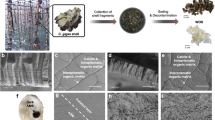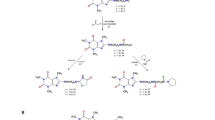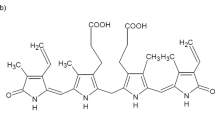Abstract
CHLOROCRUORIN is the name given in 1867 by Sir Ray Lankester to a pigment, red in concentrated solution, green dilute, dissolved in the blood plasma of Serpulid, Sabellid and Chlorhæmid polychæte worms. It has been shown (Fox, Proc. Roy. Soc., in the press) that the chlorocruorin molecule is constructed on the same model as that of hæmoglobin. Oxy- and reduced chlorocruorin resemble oxy- and reduced hæmoglobin spectroscopically, with the corresponding bands moved to the red in the case of chlorocruorin. In a like manner, the derivatives of chlorocruorin which correspond to hæmochromogen, hæmatin and hæmatoporphyrin resemble these substances, with the same shift of the bands to the red.
This is a preview of subscription content, access via your institution
Access options
Subscribe to this journal
Receive 51 print issues and online access
$199.00 per year
only $3.90 per issue
Buy this article
- Purchase on Springer Link
- Instant access to full article PDF
Prices may be subject to local taxes which are calculated during checkout
Similar content being viewed by others
Author information
Authors and Affiliations
Rights and permissions
About this article
Cite this article
FOX, H. On a New Porphyrin. Nature 117, 49–50 (1926). https://doi.org/10.1038/117049a0
Issue Date:
DOI: https://doi.org/10.1038/117049a0
Comments
By submitting a comment you agree to abide by our Terms and Community Guidelines. If you find something abusive or that does not comply with our terms or guidelines please flag it as inappropriate.



